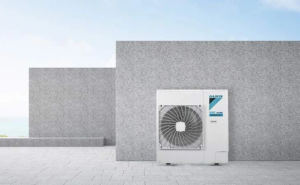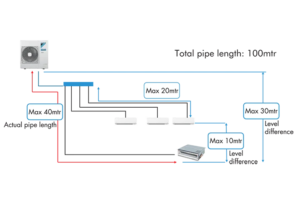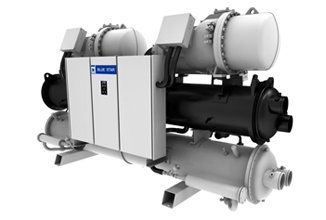The Daikin Variable Refrigerant Volume (VRV) system is a sophisticated air conditioning solution designed for large buildings and complex HVAC requirements. It is known for its efficiency, flexibility, and advanced technology. Here is a detailed overview of the Daikin VRV system:
What is a VRV System?
- Variable Refrigerant Volume (VRV): This technology allows for the precise control of the amount of refrigerant flowing to each indoor unit, based on the cooling or heating demand of each area or zone.
- Modular Design: VRV systems are modular, allowing for easy expansion and scalability. Multiple outdoor units can be connected to numerous indoor units.

Key Components of a VRV System
- Outdoor Units: These are the main refrigeration units that can connect to multiple indoor units. They design to handle large capacity and provide efficient cooling and heating.
- Indoor Units: Various types, including wall-mounted, ceiling cassette, ducted, and floor-standing units. Each type serves different installation requirements and aesthetic preferences.
- Refrigerant Piping: Network of pipes that distribute the refrigerant from the outdoor units to the indoor units.
- Control Systems: Advanced control systems for monitoring and adjusting the performance of the system. This includes central controllers, individual remote controllers, and building management systems (BMS) integration.
Features and Benefits
- Energy Efficiency: VRV systems are highly energy-efficient due to their ability to modulate refrigerant flow based on real-time demand. This reduces energy consumption compared to traditional HVAC systems.
- Individual Zone Control: Each indoor unit control independently, allowing for customized comfort in different areas of a building. This is particularly useful for multi-tenant buildings or spaces with varying usage patterns.
- Flexibility and Scalability: The modular nature of VRV systems allows for easy expansion. Additional units add as the building’s needs grow.
- Heat Recovery: Some VRV systems offer heat recovery capabilities, where waste heat from cooling operations can be used for heating purposes, further enhancing energy efficiency.
- Quiet Operation: Advanced technology and design result in quiet operation, both indoors and outdoors.
- Smart Controls: Integration with smart building systems and IoT devices allows for remote monitoring, diagnostics, and control via mobile apps and cloud services.
- Space Saving: Compact and versatile design options for both indoor and outdoor units make it suitable for space-constrained installations.
Applications
- Commercial Buildings: Office buildings, shopping malls, hotels, and other commercial spaces where efficient and flexible HVAC solutions are required.
- Residential Buildings: Luxury apartments, condominiums, and large residential homes.
- Institutional Buildings: Schools, hospitals, and universities benefit from the system’s ability to maintain precise climate control across diverse environments.
Installation and Maintenance
- Professional Installation: Requires skilled and experienced technicians for proper installation and setup, ensuring optimal performance and longevity.
- Regular Maintenance: To maintain efficiency and performance, regular maintenance is essential. This includes cleaning filters, checking refrigerant levels, inspecting electrical connections, and ensuring all components are functioning correctly.

Technological Innovations
- Inverter Technology: Daikin VRV systems use inverter compressors that adjust the speed based on cooling or heating demand, providing significant energy savings and precise temperature control.
- VRV IV and VRV X Series: The latest series offer enhanced features such as continuous heating during defrost, variable refrigerant temperature (VRT) control, and improved energy efficiency.
- Intelligent Touch Manager: Advanced centralized control system that allows building managers to monitor and control multiple units, schedule operations, and optimize energy use.
Environmental Considerations
- Refrigerants: Daikin uses environmentally friendly refrigerants such as R-410A and R-32, which have lower global warming potential (GWP) compared to older refrigerants.
- Energy Certifications: VRV systems often meet or exceed various energy efficiency standards and certifications, contributing to green building initiatives and reducing overall environmental impact.
Cost Considerations
- Initial Investment: Higher upfront cost compared to traditional HVAC systems due to advanced technology and installation complexity.
- Operational Savings: Significant savings on energy bills and maintenance costs over the system’s lifespan, making it a cost-effective solution in the long term.
The Daikin VRV system represents a pinnacle of modern HVAC technology, offering a combination of efficiency, flexibility, and advanced control that is well-suited to meet the demands of complex and large-scale buildings.
Looking to install a commercial HVAC System or Duct work in your Business Area?
Contact Vipul Ac to learn about our HVAC Service
Call +91 9825636606 Today.


